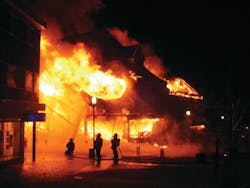The Challenges of U.S. Residential Fires
Approximately 56 percent of all structural fires in 2013 involved one- and two-family homes; yet, home fire deaths have been declining at a steady rate since I last reported on this subject early in 2007. The statistics have trended downward, at an almost steady rate, since about 1990.
The decline in fires and death rates is in spite of the increase in our population over the same period. All of this is good news. Still, it is vitally important to examine the most recent statistics to determine where we can improve — which is where the NFPA Fire Analysis and Research Division’s recent report, Fire Loss in the United States During 2013 by Michael J. Karter, Jr., becomes essential. Using this report, we can uncover challenges and weaknesses that can be addressed by improved procedures and technologies.
Defining Those at Risk
Who is more at risk in a home fire? When looking at the people most at risk, we continue to find that children and older adults face the biggest challenge. Those with disabilities also are at higher risk than the general population. Perhaps this will always be the case, but that doesn’t mean we, as alarm professionals, cannot put a dent in the statistics. We should be stressing the importance of increasing smoke detection when providing security systems to our clients representing anyone in these higher-risk categories.
Lower-income clients are another at-risk group. Again, perhaps the low-income population may always be a higher at-risk group, but even the average homeowner we sell to might be able to afford at least one smoke detector added to their residential security system. Many alarm salespeople do not realize that NFPA 72 allows you to install one or more smoke detectors to homeowners who already have a system of smoke alarms in their home that meets code. For example, if your homeowner has at least one smoke alarm on each floor, one outside each sleeping area, and one in each sleeping area, typically, they already meet code requirements (Disclaimer: The layout of smoke alarms depends on when and where the home was built, but the above protection is common for most states. Check your local codes).
The following rule has been included in NFPA 72 since the 2002 edition: “The installation of additional system-based smoke detectors, including partial or complete duplication of the smoke alarms satisfying the required minimum, shall be permitted.” This rule tells us that installing one smoke detector in a home already meeting code is exceeding the code — not violating it. If you can exceed the code and install a smoke detector or two in sleeping or laundry room areas that can actually bring the fire department, you may be contributing to saving lives.
Risk by Dwelling
Older homes in smaller communities are at the greatest risk of fires — by as much as 50 percent if that community’s population is less than 10,000. In fact, home fire deaths in communities with populations more than 10,000 — which include those with a population of more than 1 million — are actually offset by the communities of fewer than 10,000.
In other words, the three smallest size community groups of less than 2,500; 2,500 to 5,000; and 5,000 to 10,000; have a higher average percentage of fires than the remaining seven community sizes, including those of “one million or more.” A small town of less than 2,500 persons is three times more likely to have a fire than NYC.
Reducing Risk
The primary causes of many home fires continue to include smoking, children playing and cooking, in addition to arson. These causes may be best reduced through education, however, early detection from smoke detectors could still play a role in the reduction of the resulting deaths and destruction that occur in these instances.
False Alarms
According to NFPA record keepers, fire departments responded to more than 31 million emergency calls in 2013; however, fires accounted for only about four percent of these calls. Of the four percent listed as “fire emergency calls,” only seven percent were indicated as “false alarms.” The balance of these calls consisted primarily of emergency requests, especially for EMTs.
You may think the 7 percent seems low, but if you consider that it is 7 percent of more than 1.25 million, you will recognize the need for our industry’s continued vigilance to educate our customers to cut down on false alarms.
As I reported last month on commercial fire deaths remaining less than 100 per year, due to adoption of national building codes over the years, the high number of deaths occurring in one- and two-family homes needs to be acknowledged as an area of concern. Whatever you can do to promote the installation of monitored smoke detection systems in your territories will effectively reduce these future numbers.
To read the full report, Fire Loss in the United States During 2013, please visit www.nfpa.org.
Greg Kessinger is SD&I’s fire alarm and codes expert and a regular contributor. Please email him your fire & life safety questions at[email protected].
About the Author

